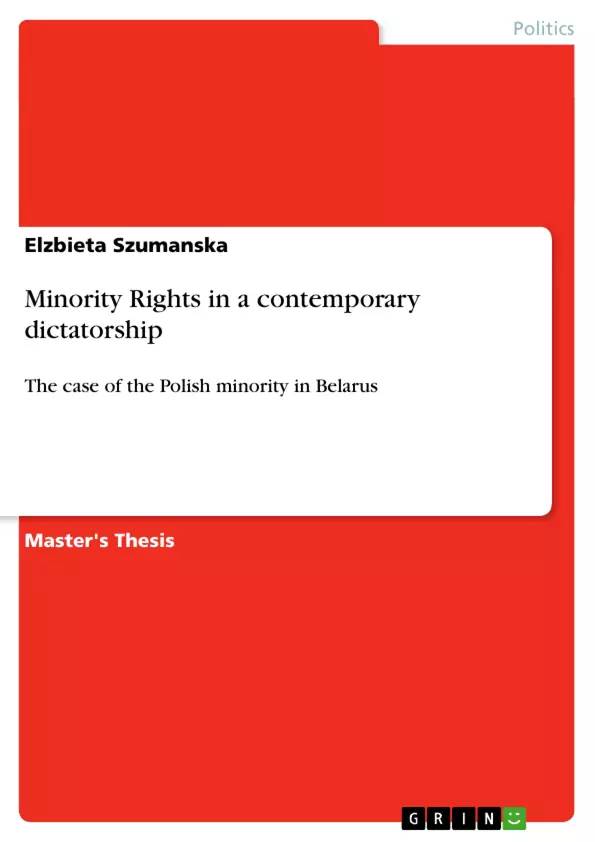The master thesis is related to significant problems in contemporary Europe – not only from the perspective of Polish people living in Belarus but also from the international
perspective.
Belarus is arguably the least democratic country in Europe. As such it has posed problems for the EU and other European and Western institutions, especially on the field of minority protection. Minorities are among the most contested issues
in political life because they speak to an inherent tension in human affairs between competing desires for freedom and belonging. The diversity, aimed by the Western political actors, simply contradicts the principle that legitimates a political community in an authoritarian state. In the case of the Belarusian
dictatorship it leads to enhanced conformity resulting in minority discrimination. The paper presents different kinds of the external influence in order to assess the most effective one(s) when defending minority rights in a dictatorship.
The 1st chapter the Author presents the ways of understanding and
considering the problems of minorities, minority rights, their protection as well as the relationship between minorities and dictatorship. The Author is highlighting research methods too.
In the 2nd chapter Ms. Szumanska concentrates on presenting the origins of dictatorship in Belarus and on how Polish minority
functions there. The Author tries to examine the situation of Poles in the contemporary Belarus. The 3rd chapter gives a good overview of regulations (internal, bilateral and international standards) related to the treatment of minorities in Belarus.
She states that practices of Belarusian authorities towards Polish minority in Belarus is incompatible with democratic standards.
The 4th chapter is an attempt to present and analyze the
impact of Western countries and international organizations on Belarusian authorities. Ms. Szumanska uses the following examples of foreign actors: USA, OSCE, EU, UUN, Russia and
Poland. Ms. Szumanska has also mentioned the influence of NGO’s in Belarus and has examined some aspects of discrimination of the Polish minority (press, Catholic practices, education, labour
market..etc.). In the last chapter “Conclusions” the Author tries to refer to aims posed in introduction, to answer the research questions and to find out why all this is taking place.
Inhaltsverzeichnis (Table of Contents)
- Introduction
- Understanding the "problem of minorities"
- Substantive law
- Minorities and a dictatorship
- Living in a dictatorship: Poles in Belarus
- From defective democracy to a dictatorship
- Polish Minority in the newly independent state of Belarus
- Obligations and monitoring
- Analyzing legal standards
- Internal standards of Belarus
- Bilateral treaty obligations
- International standards
- Analyzing monitoring mechanisms
- Treaty-based monitoring mechanisms
- Non-treaty based monitoring mechanisms
- External influence
- Strategies of international and domestic actors
- Belarus: Change or Continuity?
- Conclusions
- Summary in a foreign language
- Attachment
Zielsetzung und Themenschwerpunkte (Objectives and Key Themes)
This paper examines the situation of the Polish minority in Belarus, a country characterized by authoritarian rule. It explores the legal frameworks and external influences, particularly from Europe, that impact minority rights in this context. The paper aims to understand the challenges faced by minorities within a dictatorship and to evaluate the effectiveness of various strategies employed to promote minority rights.- The “problem of minorities” and the tension between diversity and belonging in political communities
- The impact of authoritarian regimes on minority rights, specifically in Belarus
- The role of international legal standards and monitoring mechanisms in protecting minority rights
- The effectiveness of external influence and strategies employed by international and domestic actors to promote minority rights in a dictatorship
- The potential for change or continuity in Belarus regarding minority rights
Zusammenfassung der Kapitel (Chapter Summaries)
The introduction delves into the concept of “minority rights” as a means to limit the potential instability arising from the tension between diversity and belonging in political communities. The chapter examines the historical evolution of the “problem of minorities” in Europe and the significance of the self-determination principle in shaping the nation-state system.
Chapter 2 focuses on the situation of the Polish minority in Belarus, tracing the country's transition from a defective democracy to a dictatorship. The chapter analyzes the challenges faced by the Polish minority within the newly independent state of Belarus, highlighting the impact of the authoritarian regime on minority rights.
Chapter 3 examines the legal frameworks and monitoring mechanisms that govern minority rights in Belarus. It analyzes internal standards, bilateral treaty obligations, and international standards. The chapter also explores the role of treaty-based and non-treaty based monitoring mechanisms in upholding minority rights.
Schlüsselwörter (Keywords)
This paper focuses on the themes of minority rights, authoritarianism, dictatorship, external influence, international legal standards, monitoring mechanisms, and the case of the Polish minority in Belarus. The work explores the challenges and opportunities in promoting and protecting minority rights within a repressive political environment.- Citation du texte
- BA Elzbieta Szumanska (Auteur), 2010, Minority Rights in a contemporary dictatorship, Munich, GRIN Verlag, https://www.grin.com/document/149178



